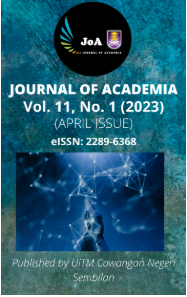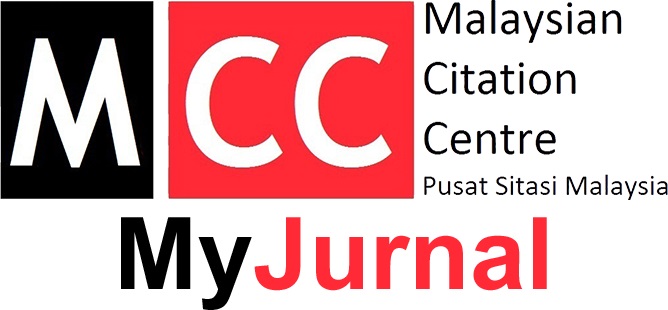ASSESSMENT OF THE CURRENT SPATIAL-TEMPORAL VARIATIONS OF TOTAL DISSOLVED SOLIDS ON THE SURFACE WATERS OF KUALA PERLIS, PERLIS
Keywords:
Estuary, Kuala Perlis, Spatiotemporal Study, Total Dissolved Solids, Water Quality MonitoringAbstract
Total dissolved solids (TDS) have a terrible impact on river water quality. The issues were compounded further by the health risks posed to residents and the uproar generated by elevated levels of total dissolved solids in the water bodies. This study aims to evaluate the spatial-temporal fluctuations of total solid content, namely total dissolved solids (TDS), on the surface water of Kuala Perlis, Perlis. In December 2021, the sampling sites were established and recorded using Global Positioning Systems (GPS). Five sampling locations were selected for each morning, afternoon, and evening session and water samples were collected and transported into the laboratory. The total dissolved solids were studied using gravimetric analysis and the American Public Health Assessment (APHA) standard. The analysis of variance (ANOVA) was set at 0.05 to determine the significant difference between the spatial-temporal mean readings of TDS using the Statistical Package for the Social Sciences (SPSS) version 26. The TDS ranges were 195.00 mg/L to 4900.00 mg/L, 325.00 mg/L to 9400.00 mg/L, and 296.00 mg/L to 8500.00 mg/L, respectively, for the morning (AM), afternoon (AF), and evening (PM) sampling times throughout five sampling stations. The research found a significant difference in the mean TDS readings concerning spatial variations (p> .05). However, there is no significant difference concerning temporal variations of TDS (p< .05) on the surface waters of Sungai Kuala Perlis. The spatiotemporal findings point to spatial heterogeneity in TDS measurement across sampling station 1, sampling station 2, and sampling station 5 and but not at any different time in Kuala Perlis. The impact of total dissolved solids concentration on living, environment, and riverine infrastructures was also adequately explored. The researcher, the government, and non-governmental organizations can use the preliminary TDS fluctuation data to prepare for the Kuala Perlis region's future social and economic growth by monitoring river health or measuring pollution. The information could also help to improve ecologically friendly river management and protect the Sungai Kuala Perlis ecosystem.
References
Afsharian, S., Khedri, P., & Valinassab, T. (2022). Spatial and temporal variation of physicochemical parameters in northern Persian Gulf. International Journal of Environmental Science and Technology, 19(3), 1121–1130. https://doi.org/10.1007/s13762-021-03187-4
American Public Health Association, A. (1999). SOLIDS (2540). In Standard Methods For the Examination of Water and Wastewater (Vol. 51, Issue 3, p. 271). https://doi.org/10.3917/nras.051.0271
Amneera, W. A., Najib, N. W. A. Z., Mohd Yusof, S. R., & Ragunathan, S. (2013). Water quality index of Perlis River, Malaysia. International Journal of Civil & Environmental Engineering, 13(2), 1–6.
Aweng, E. R., Sharifah Aisyah, S. O., Salam, M. A., & Mior, I. B. (2021). Correlation between physico-chemical water quality and river ecosystems in Malaysia rivers with different land uses. IOP Conference Series: Earth and Environmental Science, 842(1). https://doi.org/10.1088/1755-1315/842/1/012041
Bhateria, R., & Jain, D. (2016). Water quality assessment of lake water: a review. Sustainable Water Resources Management, 2(2), 161–173. https://doi.org/10.1007/s40899-015-0014-7
Brent, R. N., Kunkel, J., Tomek, Z., Buchardt, D., DeLisle, P. F., & Sivers, S. (2022). A Novel Approach to Developing Thresholds for Total Dissolved Solids Using Standardized and Experimental Toxicity Test Methods. Environmental Toxicology and Chemistry, 41(11), 2782–2796. https://doi.org/10.1002/etc.5466
Brix, K. V., Gerdes, R., Curry, N., Kasper, A., & Grosell, M. (2010). The effects of total dissolved solids on egg fertilization and water hardening in two salmonids-Arctic Grayling (Thymallus arcticus) and Dolly Varden (Salvelinus malma). Aquatic Toxicology, 97(2), 109–115. https://doi.org/10.1016/j.aquatox.2009.12.011
Che Ali, S. N. A., Kamarudzaman, A. N., & Jalil, M. F. A. (2020). Study of water quality for Sungai Perlis, Perlis during high and low tides. IOP Conference Series: Earth and Environmental Science, 476(1). https://doi.org/10.1088/1755-1315/476/1/012102
Department of Environment. (2020). Environmental Quality Report 2020. In Portal Rasmi Jabatan Alam Sekitar. https://www.doe.gov.my/portalv1/wp-content/uploads/formidable/5/Kualiti-Air-Sungai.pdf
Department of Environment. (2006). Malaysia EQR 2006. 162.
Department of Environment Malaysia. (2017). Malaysian Marine Water Quality Standard and Index.
Dietrich, A. M., & Burlingame, G. A. (2015). Critical review and rethinking of USEPA secondary standards for maintaining organoleptic quality of drinking water. Environmental Science and Technology, 49(2), 708–720. https://doi.org/10.1021/es504403t
Dugan, P., Dey, M. M., & Sugunan, V. V. (2006). Fisheries and water productivity in tropical river basins: Enhancing food security and livelihoods by managing water for fish. Agricultural Water Management, 80(1-3 SPEC. ISS.), 262–275. https://doi.org/10.1016/j.agwat.2005.07.017
Fatema, K., Wan Maznah, W. O., & Isa, M. M. (2015). Spatial variation of water quality parameters in a mangrove estuary. International Journal of Environmental Science and Technology, 12(6), 2091–2102. https://doi.org/10.1007/s13762-014-0603-2
Google Earth. (2022a). SAMPLING AF. https://earth.google.com/web/@6.41309724,100.14124234,3592.80766598a,0d,35y,0.0002h,1.2484t,0.0000r?utm_source=earth7&utm_campaign=vine&hl=en
Google Earth. (2022b). SAMPLING AM. https://earth.google.com/web/@6.40812537,100.14106085,4229.85849645a,0d,35y,-0.0034h,7.2205t,359.9992r?utm_source=earth7&utm_campaign=vine&hl=en
Google Earth. (2022c). SAMPLING PM. https://earth.google.com/web/@6.40743889,100.13957982,4593.63997479a,0d,35y,-0.0001h,6.3426t,359.9999r?utm_source=earth7&utm_campaign=vine&hl=en
Halder, J., & Islam, N. (2015). Water Pollution and its Impact on the Human Health. Journal of Environment and Human, 2(1), 36–46. https://doi.org/10.15764/eh.2015.01005
Hao, X. M., Chen, Y. N., & Li, W. H. (2009). Impact of anthropogenic activities on the hydrologic characters of the mainstream of the Tarim River in Xinjiang during the past 50 years. Environmental Geology, 57(2), 435–445. https://doi.org/10.1007/s00254-008-1314-0
Hashim, A. R., Kamaruddin, S. A., Abd.Aziz, K. N., Tajam, J., Buyong, F., Azis, T. M. F., & Anscelly, A. (2022). Assessment of the Current Spatial-Temporal Variations of pH on the Surface Waters of Kuala Perlis, Perlis. Journal of Tourism, Hospitality, and Environment Management (JTHEM), 7(28), 52–65. https://doi.org/10.35631/JTHEM.728004.This
Jordan, C. E., & Fairfax, E. (2022). Beaver: The North American freshwater climate action plan. Wiley Interdisciplinary Reviews: Water, 9(4), 1–13. https://doi.org/10.1002/wat2.1592
Kaletova, T., Arifjanov, A., Samiev, L., & Babajanov, F. (2022). Importance of river sediments in soil fertility. Journal of Water and Land Development, 52, 21–26. https://doi.org/10.24425/jwld.2021.139939
Kamaruddin, S. A., Abd.Aziz, K. N., Roslani, A., Zainol, Z. E., Ahmad, A., Shaari, M. I., Nazri, R., & Tajam, J. (2022). The Mapping of Salinity Level Using The Inverse Distance Weighted (IDW) Interpolation Method Along The Coastal Area of Pulau Tuba, Langkawi. Malaysian Journal of Sustainable Environment, 9(1), 55. https://doi.org/10.24191/myse.v9i1.17292
Downloads
Published
Issue
Section
License
Copyright (c) 2023 Journal of Academia

This work is licensed under a Creative Commons Attribution-NonCommercial-NoDerivatives 4.0 International License.












